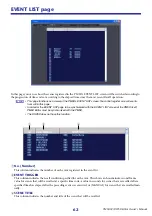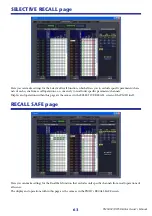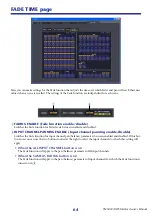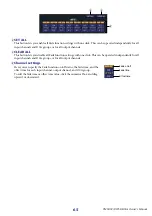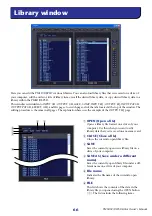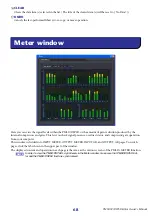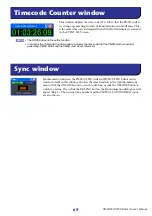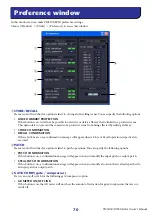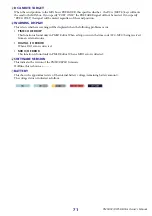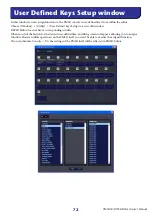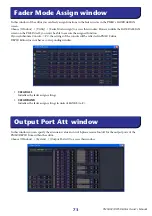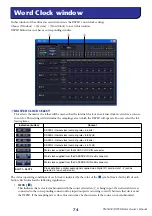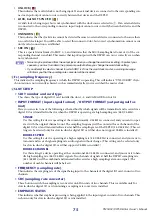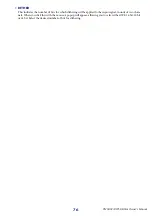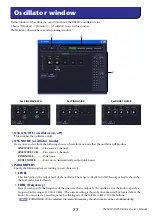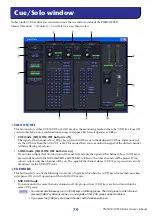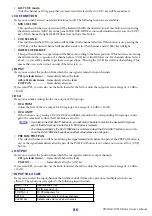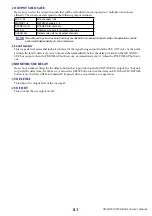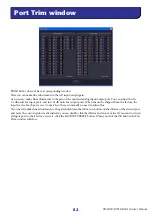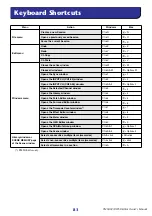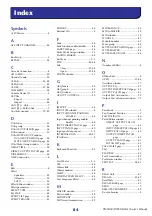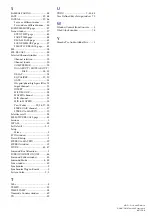
PM5DV2/DSP5D Editor Owner’s Manual
75
• UNLOCK (
)
This indicates that a valid clock is not being input. If an external device is connected to the corresponding con-
nector, input/output cannot occur correctly between that device and the DSP5D.
• LOCK, but NOT SYNC’ED (
)
A valid clock is being input, but is not synchronized with the clock source selected in
1
. If an external device
is connected to the corresponding connector, input/output cannot occur correctly between that device and the
DSP5D.
• UNKNOWN (
)
This indicates that the clock status cannot be detected because no external device is connected or because there
is no valid clock input. You will be able to select this connector/slot, but correct synchronization cannot occur
until a valid connection is established.
• SRC ON (
)
This is a special status limited to SLOT 1–2, and indicates that the SRC (Sampling Rate Converter) of the cor-
responding channel is enabled. This means that input/output with the DSP5D can occur correctly even when
not synchronized.
• Noise may be produced from the output jacks when you change the word clock setting. To protect your
speakers, you must turn down the power amp output before you change the word clock setting.
• If you attempt to select a channel for which SRC is On as the word clock master, a warning message
will inform you that the sampling rate converter will be disabled.
B
Fs (sampling frequency)
This indicates the sampling frequency at which the DSP5D is operating. This will indicate “UNLOCKED” if syn-
chronization is not currently achieved, such as immediately after you’ve switched the master clock.
C
SLOT SETUP
• SLOT number and card type
This shows the type of digital I/O card installed in slots 1–2, and CASCADE for slots 3/4.
• INPUT FORMAT (input signal format) / OUTPUT FORMAT (output signal for-
mat)
Here you can select one of the following as the method by which signals will be transmitted and received via a
digital I/O card installed in the slot when the DSP5D is operating at a high sampling rate (88.2/96 kHz).
SINGLE
Use this setting if a device operating at the conventional 44.1/48 kHz is connected, and you want to oper-
ate it with the original channel count. The sampling frequency will be converted for each channel of the
digital I/O card, and transmitted/received at half the sampling rate of the DSP5D (44.1/48 kHz). (This set-
ting can be selected only for slots in which a digital I/O card that does not support 96 kHz is installed.)
DOUBLE SPEED
Use this setting if a device operating at a high sampling rate (88.2/96 kHz) is connected, and you want to
transmit and receive high sampling rate audio signals without change. (This setting can be selected only
for slots in which a digital I/O card that supports 96 kHz is installed.)
DOUBLE CHANNEL
Use this setting if a device operating at the conventional 44.1/48 kHz is connected, and you want it to han-
dle high sampling rate (88.2/96 kHz) signals. Two channels of signals at half the DSP5D’s sampling rate
(44.1/48 kHz) will be combined and transmitted/received as a high sampling rate mono signal. (The
number of usable channels will be halved.)
• FREQUENCY (sampling rate)
This indicates the sampling rate of the signal being input to the channels of the digital I/O card, in units of two
channels.
• SRC (sampling rate converter)
These buttons switch the sampling rate converter on/off in units of two channels. This is available only for
slots in which a digital I/O card containing a sampling rate converter is installed.
• EMPHASIS STATUS
This indicates whether emphasis processing is being applied to the input signal, in units of two channels. This
is shown only for slots in which a digital I/O card is installed.
NOTE


